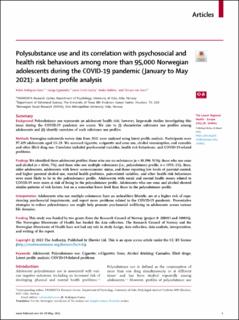Polysubstance use and its correlation with psychosocial and health risk behaviours among more than 95,000 Norwegian adolescents during the COVID-19 pandemic (January to May 2021): a latent profile analysis
Rodriguez Cano, Ruben; Kypriotakis, George; Cortes Garcia, Laura; Bakken, Anders; von Soest, Tilmann Martin
Peer reviewed, Journal article
Published version
Permanent lenke
https://hdl.handle.net/11250/3117561Utgivelsesdato
2023Metadata
Vis full innførselSamlinger
- NOVA andre dokumenter [95]
- Publikasjoner fra Cristin [3269]
Sammendrag
Background Polysubstance use represents an adolescent health risk; however, large-scale studies investigating this issue during the COVID-19 pandemic are scarce. We aim to (i) characterise substance use profiles among adolescents and (ii) identify correlates of such substance use profiles.
Methods Norwegian nationwide survey data from 2021 were analysed using latent profile analysis. Participants were 97,429 adolescents aged 13–18. We assessed cigarette, e-cigarette and snus use, alcohol consumption, and cannabis and other illicit drug use. Correlates included psychosocial variables, health risk behaviours, and COVID-19-related problems.
Findings We identified three adolescent profiles; those who use no substances (n = 88,890; 91%); those who use snus and alcohol (n = 6546; 7%); and those who use multiple substances (i.e., polysubstance profile; n = 1993; 2%). Boys, older adolescents, adolescents with lower socio-economic status, and those reporting low levels of parental control, and higher parental alcohol use, mental health problems, pain-related variables, and other health risk behaviours were most likely to be in the polysubstance profile. Adolescents with social and mental health issues related to COVID-19 were more at risk of being in the polysubstance profile. Adolescents who use snus and alcohol showed similar patterns of risk factors, but on a somewhat lower level than those in the polysubstance profile.
Interpretation Adolescents who use multiple substances have an unhealthier lifestyle, are at a higher risk of expe- riencing psychosocial impairments, and report more problems related to the COVID-19 pandemic. Preventative strategies to reduce polysubstance use might help promote psychosocial well-being in adolescents across various life domains.

